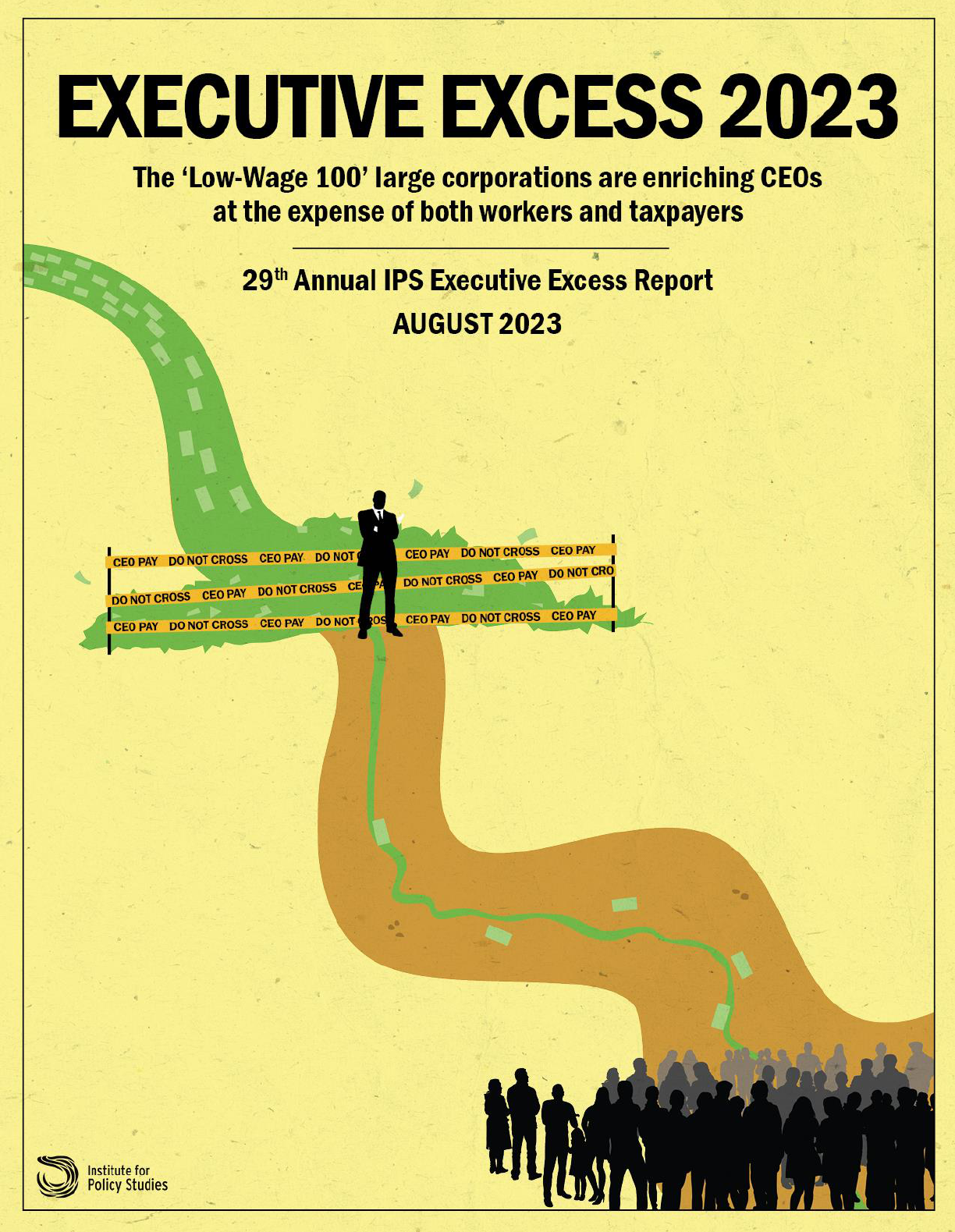
August 14 draft

Author: Sarah Anderson directs the Global Economy Project and co-edits Inequality.org at the
Institute for Policy Studies. She has co-authored the more than 20 previous IPS annual Executive
Excess reports and testified before the Senate Budget Committee on this issue in 2021 and 2012.
Research and editorial assistance: Jasmine Corazon, Kufre McIver, and Sam Pizzigati.
Cover design: Sarah Gertler.
Acknowledgements: Thanks to Scott Klinger of Jobs With Justice, Bart Naylor of Public Citizen,
Jessica Church of Take on Wall Street, and Natalia Renta of Americans for Financial Reform for
expert comments on this report.
The Institute for Policy Studies (IPS-DC.org), a multi-issue research center, has been conducting path-
breaking research on executive compensation for nearly three decades.
The IPS Inequality.org website (Inequality.org) provides an online portal into all things related to the
income and wealth gaps that so divide us, in the United States and throughout the world. Sign up for
our weekly newsletter at: Inequality.org/subscribe.
Twitter and Facebook: @inequalityorg
Institute for Policy Studies
1301 Connecticut Ave. NW, Suite 600
Washington, DC 20036
202 234-9382
www.ips-dc.org, Twitter: @IPS_DC
Facebook: http://www.facebook.com/InstituteforPolicyStudies
Email: sarah@ips-dc.org
© 2023 Institute for Policy Studies

Contents
Key findings………………………………………………………………………………..…………….…….… 1
Introduction …………………………………………….…………………………………………………….….. 4
The Low-Wage 100: CEO pay, median worker pay, and pay ratios ………………………….…………… 5
The Low-Wage 100: Stock buybacks and CEO stock ownership ………………………………………..... 6
The Low-Wage 100: Federal contracts and subsidies……………………………………………………..…. 8
Policy recommendations …………………………………………………………………...………….………. 10
Methodology and sources…………….………………....…………….……………….…...…….………..….. 12
Appendix 1: The 100 S&P 500 companies with the lowest median worker wages ..…..……………..… 13
Appendix 2: Our annual menu of CEO pay reforms ……………………………..………..………......…... 17

1
Key findings
This 29
th
annual Executive Excess report takes an in-depth look at the 100 S&P 500 corporations that had the
lowest median worker pay levels in 2022, a group we’ve dubbed the “Low-Wage 100.” We analyze, for
each of these firms, the total compensation and personal stock holdings of CEOs, the CEO-worker pay gap,
and the overall outlays for stock buybacks. We also reveal how taxpayers are enriching ― through federal
contracts ― the majority of the Low-Wage 100.
1. The CEO-worker pay gap at the Low-Wage 100 averaged 603 to 1 in 2022
Low-Wage 100 CEO pay averaged $15.3 million and median worker pay averaged $31,672 in 2022.
Live Nation Entertainment sported the fattest CEO paycheck and the widest pay gap. Michael
Rapino hauled in $139 million, 5,414 times as much as his firm’s $25,673 median pay.
Aptiv, a vehicle parts maker with federal government contracts, had the lowest median pay, just
$8,139 for a full-time manufacturing worker in Mexico. Stanley Black & Decker reported the
highest, $47,651, but did not disclose details about the location or status of its median worker.
2. The Low-Wage 100 have spent more than $340 billion on stock buybacks since 2020
Between January 1, 2020 and May 31, 2023, 90 of the Low-Wage 100 reported combined stock
buyback expenditures of $341.2 billion. This financial maneuvering artificially inflates executive
stock-based pay and siphons funds from worker wages and other productive investments.
Lowe’s led the buybacks list, with $34.9 billion over the past three and a half years. In 2022 alone,
Lowe’s spent $14.1 billion on buybacks, enough to give every one of its 301,000 U.S. employees a
$46,923 bonus. In 2022, Lowe’s CEO Marvin Ellison enjoyed annual compensation of $17.5 million.
The retailer’s median annual worker pay: a mere $29,584.
Home Depot came in second in our buyback rankings, with $28.9 billion in stock buybacks over the
course of our study period. CEO Edward Decker kept the spigot flowing furiously after taking
Home Depot’s helm in 2022. The company’s repurchases have totaled over $5.7 billion since last
October. In 2022, Decker made 491 times Home Depot’s median pay of $30,100.
Walmart ranks third on the buybacks list, with nearly $23.9 billion. CEO Doug McMillon took in
$25.3 million in 2022 while half of his employees earned less than $27,136.

2
3. During their stock buyback spree, Low-Wage 100 CEOs’ personal stock holdings
increased more than three times as fast as their firms’ median worker pay
The CEOs of the 90 Low-Wage 100 companies that have spent funds on buybacks own
approximately $14.9 billion worth of their company stock.
At the 65 buyback companies where the same person held the top job between 2019 and 2022, the
CEOs’ personal stock holdings soared 33 percent to an average of $184.7 million. Median pay at
these firms rose only 10 percent to an average of $31,972. These figures do not reflect inflation
because the median pay figures cover a global workforce.
Dollar Tree CEO Michael Witynski reaped the single largest stock gain. During his three-year stint
at the helm, his stock holdings ballooned 2,393 percent to $30.5 million while Dollar Tree’s median
pay fell 4.4 percent to just $14,702. Over this three-year span, the retailer spent over $2 billion in
company resources on buybacks.
FedEx CEO Frederick Smith has the largest stockpile in the Low-Wage 100. His personal holdings
have grown 65 percent to more than $5 billion since January 2020. By contrast, FedEx median
worker pay fell by 20 percent to $39,177, a total that includes $9,267 in health benefits, between 2019
and 2022. See more FedEx details below in the contractor section.
4. Over half of the Low-Wage 100 receive taxpayer-funded federal contracts
Of the 100 companies in our sample, 51 received federal contracts worth a combined $24.1 billion
during fiscal years 2020-2023. These contractors spent nearly $160 billion on stock buybacks over
the course of these years.
In 2022, the average CEO pay in this low-wage contractor group stood at $12.7 million, 56 times as
much as the salary of a Biden administration cabinet secretary. This group’s CEOs averaged 438
times their $34,550 median worker pay.
Amazon, the largest contractor in the Low-Wage 100, amassed at least $10.4 billion in federal deals,
with most of that haul coming from a National Security Agency web services contract. The
company has reportedly received additional classified defense contracts. Under CEO Andy Jassy’s
two years at the helm, Amazon has spent $5.9 billion on stock buybacks, an outlay that has helped
inflate Jassy’s personal stock holdings to $265 million. These millions do not include the bulk of his
2021 mega-grant, a reward that will vest over 10 years.
FedEx, the second-largest contractor on our list, pocketed $6.2 billion from Uncle Sam in fiscal years
2020-2023. FedEx spent $3.6 billion on buybacks during this period, a maneuver that helped prop
up the value of Smith’s more than $5 billion in personal stock holdings, the largest stash held by
any CEO in the Low-Wage 100. In 2022, his last year before transitioning to the FedEx executive
chair slot, Smith made $10.6 million, 271 times FedEx median worker pay and 47 times the salary of
the U.S. secretary of veterans affairs. Unlike competitor UPS, where more than 70 percent of
employees are unionized, FedEx has been and continues to be notoriously anti-union.

3
5. Policy solutions for runaway CEO pay are gaining support
Policymakers have begun taking serious steps to respond to public outrage — across the political
spectrum — over executive excess.
Stock buybacks taxes and restrictions: In the 2022 Inflation Reduction Act, Congress passed a 1
percent excise tax on CEO pay-inflating stock buybacks. President Biden proposed quadrupling this
tax in his 2023 State of the Union address. Biden has also included a proposal in his federal budget
plan that would ban top executives from selling their personal stock for a multi-year period after a
buyback, preventing CEOs from timing share repurchases to cash in personally on a short-term
price pop they themselves artificially created. A Senate bill, the ALIGN Act, would do just that.
Federal contractor incentives: In 2022, the Department of Commerce announced plans to give
priority in the awarding of new CHIPS subsidies for domestic semiconductor manufacturing to
firms that do not engage in any stock buybacks. The administration has applied a number of other
pro-worker conditions on federal contracts, but federal agencies could go much further to wield the
power of the public purse against inequality. The Patriotic Corporations Act could serve as a
model. This bill would grant preferential treatment in contracting to firms with pay ratios of 100 to
1 or less, among other benchmarks, including neutrality in union organizing campaigns.
Excessive CEO pay tax: Laws to hike corporate taxes on companies with wide CEO-worker pay
gap are now raising revenue in two major cities, San Francisco and Portland, Oregon. The more
recent of the two taxes, San Francisco’s “Overpaid Executive Tax,” became effective on January 1,
2022. In May 2023, city officials announced that they now expect the tax to bring in about $125
million per year, a higher return than originally expected. San Francisco’s executive tax has also
proved more resilient than other local revenue sources. Legislation similar to San Francisco’s has
been introduced in the U.S. House and Senate and came into play during the Build Back Better
negotiations. Higher tax rates on companies with wide CEO-worker pay gaps create an incentive to
both rein in executive pay and lift up worker wages, all while generating significant new capital for
vital public investments.

4
Introduction
In response to strikes and union organizing drives, corporate leaders routinely insist that they simply lack
the wherewithal to raise employee pay. And yet top executives seem to have little trouble finding
resources for enriching themselves and wealthy shareholders.
In 2021 and 2022, S&P 500 corporations spent record sums on stock buybacks, a maneuver that artificially
inflates the value of a company’s stock — and CEOs’ stock-based pay. All employees contribute to
company profits. But instead of broadly sharing the wealth, companies are using a once-illegal form of
market manipulation to make those at the top of the corporate ladder even richer. This report examines the
buyback activities of the 100 S&P 500 companies that pay the lowest median wages, the “Low-Wage 100.”
Why do stock buybacks pose a problem for both workers and the economy?
Every dollar spent on stock buybacks is a dollar not spent on worker wages, R&D, and other productive
investments that would stimulate long-term growth. Analysts have well documented the association
between buybacks and reduced capital investment and innovation, wage stagnation, and even layoffs.
By artificially inflating CEO pay, buybacks also significantly drive today’s staggering economic inequality.
In 2022, the CEO-to-worker pay ratio stood at 272-to-1 for S&P 500 companies, according to the latest AFL-
CIO analysis. Study after study has shown that such extreme gaps actually undermine the corporate
bottom line by reducing employee morale and productivity and raising turnover rates. We have compiled
a bibliography of such studies from business schools, management consulting firms, and Treasury
Secretary Yellen’s academic work.
Extreme pay disparities also widen gender and racial disparities, since women and people of color make
up a disproportionately large share of low-wage workers and a tiny share of corporate leaders. In 2022,
women held only slightly more than 10 percent of Fortune 500 CEO positions while making up 63.5 percent
of workers earning the federal minimum wage. Black CEOs currently lead just 8 percent of Fortune 500
corporations.
The vast majority of Americans — no matter their political party affiliation — see these disparities as
unacceptable. One 2022 poll shows 87 percent of our nation viewing the growing gap between CEO and
worker pay as a definite problem.
What can we do about these obscene divides? This annual Executive Excess report ends with the most
comprehensive available policy menu for achieving a fair corporate compensation system. Recent steps
forward, particularly those that discourage CEO pay-inflating stock buybacks, are encouraging. But much
more needs to be done to ensure that the fruits of everyone’s labor are equitably shared.

5
The Low-Wage 100
CEO pay, median worker pay, and pay ratios
Since 2018, the Securities and Exchange Commission has required publicly held firms to annually report
both median worker pay — the middle value on a company’s pay scale — and the ratio between CEO pay
and that median. These median pay numbers offer a revealing look at how well or poorly firms are sharing
their rewards.
This report zeroes in on the 100 S&P 500 companies with the lowest median wages in 2022, a figure based
on a company’s global workforce, including part- and full-time employees. Last year, median worker pay
at these Low-Wage 100 companies averaged $31,672, and the gap between CEO and median worker pay at
these enterprises averaged 603 to 1.
Pay Disparities in 2022
CEO pay, $million
Median worker pay
CEO-worker pay ratio
Low-Wage 100 Average
$15.3
$31,672
603
The 5 S&P 500 firms with the lowest median pay
Aptiv
$16.21
$8,139
1,991
Western Digital
$32.14
$9,644
3,332
Ross Stores
$11.34
$9,968
1,137
Yum Brands
$16.67
$10,398
1,603
Bath & Body Works
$6.91
$10,669
934
Source: Corporate proxy statements filed with the SEC. See Appendix 1 for details on the full Low-Wage 100.
The SEC requires firms to calculate median worker pay based on their global workforce. Given this
requirement, we might assume that the companies with the lowest wage levels must have most of their
employees in developing countries. But this is definitely not the case. Three companies that operate
primarily in the United States ― Ross Stores, Yum Brands (owner of KFC, Pizza Hut, Taco Bell), and Bath
& Body Works ― rank among the top five firms that dominate the lowest-wage list. These retail and fast
food firms have chosen a business model that relies overwhelmingly on part-time employees with few
benefits.
Another U.S.-based firm, Live Nation Entertainment, ranks first on our list for the largest CEO paycheck
and the widest pay gap. Michael Rapino hauled in $139 million, 5,414 times as much as the concert giant’s
median pay of $25,673 in 2022. In its proxy statement, the company takes great pains to point out that if
you nix the CEO’s $109 million stock grant and all of the company’s primarily part-time employees from
the calculation, the Live Nation pay ratio would be merely 353 to 1.

6
The Low-Wage 100
Stock buybacks and CEO stock ownership
Stock buybacks were considered stock manipulation and largely banned until 1982, when President
Reagan's SEC legalized them, allowing executives with stock-based pay to create huge windfalls for
themselves and shareholders at the expense of workers and productive investments. We reviewed
quarterly reports filed by the Low-Wage 100 between January 1, 2020 and May 31, 2023 and found that 90
of the firms had spent profits on buybacks at a combined cost of $341.2 billion.
How have CEOs personally benefited from this stock buyback spree? We poured through the footnotes in
company proxy statements to determine that the CEOs in the Low-Wage 100 that have spent funds on
buybacks since 2020 now own approximately $14.9 billion worth of their company stock. That would be
enough to double the pay of nearly a half million workers earning $30,000 per year.
We zeroed in on the 65 buyback companies where the same person held the top job between 2019 and 2022.
Since 2020, these CEOs’ personal stock holdings have increased 33 percent ― to an average of $184.7
million ― while median pay at these firms rose only 10 percent to a $31,972 average. These figures do not
take inflation into account because the median must reflect a global workforce.
The Low-Wage 100 Corporations That Spent the Most on Stock Buybacks
Value of CEO
stock holdings
Stock buyback
expenditures ($million)
Total U.S.
employees,
2022
2022
buyback
expenditure
per U.S.
employee
Median
worker
pay, 2022
As of July
7, 2023
($million)
% change,
January 6,
2020-July 7,
2023
Reported
January 1,
2020-May 31,
2023
2022 only
Lowe’s
$108.3
754%
$34,949
$14,123
301,000
$46,923
$29,584
Home Depot
$50.3
n/a – new
CEO
$28,857
$6,633
418,900
$15,833
$30,100
Walmart
$284.6
35%
$23,861
$9,866
1,600,000
$6,166
$27,136
Sources: Corporate proxy statements and 10-K and 10-Q reports. See Appendix 1 for details on the full Low-Wage 100.
Lowe’s: This home improvement chain has spent $34.9 billion repurchasing its own stock over the past
three and a half years. In 2022 alone, Lowe’s spent more than $14.1 billion on stock buybacks. If those
funds had instead been divided among the company’s 301,000 U.S. employees, the retailer could have
given each worker a $46,923 bonus. Instead, Lowe’s median worker pay remains below $30,000 while CEO
Marvin Ellison is sitting on over $108 million in company stock, up 754 percent since the start of 2020.
Home Depot: Lowe’s and Home Depot compete vigorously in both the home improvement industry and
in buyback spending. The company blew $6.6 billion on buybacks in 2022, enough to give all 418,900 U.S.

7
Home Depot employees a $15,833 bonus. The company chose instead to manipulate its share price to create
windfalls for executives and wealthy shareholders. Edward Decker, who took the company’s helm in 2022,
holds more than $50 million in company stock. His firm’s typical employee earns just $30,100.
Walmart: The country’s largest employer last year spent $9.9 billion repurchasing company stock, enough
for a $6,166 bonus for each of Walmart’s 1.6 million U.S. employees. Half of the giant retailer’s employees
made less than $27,136 in 2022. CEO Doug McMillon, meanwhile, has amassed nearly $285 million in
Walmart stock, up an estimated 35 percent in value since the beginning of 2020.
The CEOs of Low-Wage 100 Corporations With the Largest Increases in Their Stock Holdings
CEO in 2022
Stock buyback
expenditures,
reported
January 1, 2020-
May 31, 2023
($million)
Value of CEO
stock holdings
($million)
CEO total
compensation,
2022 ($million)
Median
worker
pay,
2022
CEO-
worker
pay ratio,
2022
As of
July 7,
2023
% change,
January 6,
2020-July
7, 2023
Dollar Tree
Michael Witynski
$2,149
$30.5
2,393%
$13.98
$14,702
951
Tapestry
Joanne Crevoiserat
$2,100
$10.9
1,482%
$13.74
$29,147
471
Nike
John Donahoe II
$8,920
$18.6
769%
$28.84
$37,410
771
Sources: Corporate proxy statements and 10-K and 10-Q reports. See Appendix 1 for details on the full Low-Wage 100.
The CEOs with the largest increases in their stock holdings, all relatively new chief execs, have quickly
amassed large stockpiles amid widespread low pay among their most typical workers.
Dollar Tree: CEO Michael Witynski reaped the biggest stock gain in the Low-Wage 100. During his three-
year stint before resigning in early 2023, his personal stock holdings ballooned 2,393 percent to $30.5
million. Dollar Tree’s median pay fell 4.4 percent to just $14,702 in the same time period, while the
retailers’ customers saw an increase in most products from $1 to $1.25. The retailer has spent over $2 billion
on buybacks since 2020.
Tapestry: Joanne Crevoiserat, after moving from CFO to CEO status in 2020, has amassed nearly $11
million in company stock, a holding up 1,482 percent in value since 2020. Half of the luxury brand’s
employees annually make less than $29,147, a reality that leaves them unlikely to ever carry one of the
company’s high-end Coach handbags. Tapestry median pay increased only 2 percent between 2019 and
2022, not accounting for inflation.
Nike: The athletic wear giant has spent, since John Donahoe II took the CEO job in January 2020, nearly $9
billion on buybacks. That outlay contributed to a 769 percent hike in Donohoe’s stock holdings to nearly
$19 million last month. Meanwhile, half of the company’s 77,239 global employees make less than $37,410.

8
The Low-Wage 100
Federal contracts and subsidies
Ordinary U.S. taxpayers are supporting our inequitable corporate economic order through the hundreds of
billions of federal contracts and subsidies that flow every year to for-profit businesses.
Among the Low-Wage 100, 51 received federal contracts worth a combined $24.1 billion during fiscal years
2020-2023. These low-wage federal contractors spent nearly $160 billion on stock buybacks during this
period. In 2022, the average CEO pay at these low-wage contractors stood at $12.7 million while the
group’s average CEO-worker pay ratio hit 438-to-1. The median worker pay: $34,550.
CEO pay apologists regularly argue that corporate leaders deserve their massive compensation packages
because they bear enormous responsibilities and must take extraordinary risks. This argument quickly falls
apart when we compare CEOs at major contractors with the government officials ultimately responsible for
their contracts.
The U.S. secretary of defense, for instance, manages the country’s largest workforce — more than 2 million
employees — and makes life-and-death decisions on a daily basis. And yet this defense secretary and other
Biden cabinet members make just $226,300 per year. The average $12.7-million CEO compensation in our
low-wage contractor group runs 56 times higher than the current take-home of our cabinet secretaries. The
ratio between cabinet secretary pay and the $80,320 average federal employee pay now runs less than three
to one.
The only current restraint on top-level federal contractor pay remains a cap on how much contactors can
expect the federal government to directly reimburse them for chief executive compensation. In 2022, that
cap stood at $589,000 per executive. But this regulation in no way curbs the windfalls that contracts can
generate for companies and their top executives. Lucrative government deals boost corporate earnings and
share prices, and those increases, in turn, inflate CEO pay.
The Low-Wage Corporations with the Largest Federal Contracts
Company
CEO
CEO pay,
2022
Median
worker
pay, 2022
Pay
ratio,
2022
Federal
contracts,
FY20-23
Primary purpose of
contracts
Amazon.com
Andy Jassy
$1,298,723*
$34,195
38*
$10,403,985,746
Web services
FedEx
Frederick Smith
$10,596,150
$39,177
271
$6,162,738,757
Mail services
Johnson Controls
George Oliver
$14,929,350
$47,588
314
$1,960,631,899
Energy systems
Sources: Corporate proxy statements and USAspending.gov. See Appendix 1 for details on the full Low-Wage 100.
*Jassy accepted modest pay in 2022 after receiving a 2021 stock grant valued at $212 million.

9
Amazon: We were able to gather information on $10.4 billion in Amazon contracts during the FY2020-2023
period, including $10 billion to provide web services for the National Security Agency. But the full extent
of Amazon’s taxpayer-funded contracts remains unknown. The company reportedly also received a
lucrative share of a multi-billion-dollar CIA contract for cloud services. The details and exact value of this
contract continue to be classified. Amazon is also in the running for a share of another $9 billion Defense
Department cloud services contract.
In his first year at the helm in 2021, Amazon CEO Andrew Jassy raked in compensation valued at $212.7
million, nearly all of it in stock-based awards that will vest over a decade. That sum is 6,474 times the
company’s median pay and 961 times the salary for the U.S. secretary of defense. In 2022, the company
bumped up its spending on anti-union consultants to more than $14 million to fight campaigns at several
warehouses, including the State Island site where management is still refusing to negotiate a contract, more
than a year after workers voted in the first U.S.-based Amazon union.
FedEx: During FY2020-2023, FedEx raked in nearly $6.2 billion in federal contracts to provide mail
services that included pharmaceutical deliveries for the Veterans Administration. The FedEx deals with
Uncle Sam dwarf the $1.4 billion their leading competitor, United Parcel Service, received in federal
business during this period. Both UPS and the public Postal Service have heavily unionized workforces.
FedEx management, by contrast, has opposed organizing efforts, and the firm currently has a minimal
union presence outside its pilot crew.
CEO Fred Smith spent $3.6 billion on buybacks between 2020 and July 2023, a maneuver that helped prop
up the value of his personal stock holdings — the largest of any CEO in the Low-Wage 100. His personal
holdings have grown 65 percent, to more than $5 billion, over the past three and a half years. By contrast,
FedEx median worker pay fell by 20 percent to $39,177, including $9,267 in health benefits, between 2019
and 2022. Smith made $10.6 million in 2022, his last year before transitioning to the company’s executive
chair position. That $10.6 million rates as 271 times the FedEx median worker pay and 47 times the salary
of the U.S. cabinet secretary of veterans affairs.
Johnson Controls: Originally based in Milwaukee, Johnson Controls moved its headquarters to Ireland in
2016 to lower its U.S. tax bill. But the company continues to receive major taxpayer-funded federal
contracts, a haul worth nearly $2 billion in FY2020-2023, primarily for upgrading federal buildings to a
more energy-efficient status. The firm could receive considerably more over coming years, thanks to new
infrastructure and energy legislation. Under CEO George Oliver’s leadership, the firm has spent $4.5
billion on stock buybacks since 2020. That contributed to a 139 percent increase in his personal
stockholdings, to $131.7 million. In 2022 Oliver made 314 times as much as his typical employee.

10
Policy Recommendations
We highlight here three areas of CEO pay policy reforms that have gained traction in recent years.
Appendix 2 catalogs a much more extensive menu of options.
Stock buybacks taxes and restrictions
Before 1982, federal rules generally treated buybacks as illegal stock manipulation. Several bills, including
the Reward Work Act (HR 3694) championed by Rep. Chuy Garcia (D-IL), have been introduced to
reinstate that ban. Recent reforms move the ball in that direction.
The 2022 Inflation Reduction Act introduces a 1 percent excise tax on CEO pay-inflating stock buybacks.
President Biden proposed quadrupling this tax in his 2023 State of the Union address.
Biden has also included in his federal budget proposals restrictions on the sale of executives’ personal
stock after a buyback to prevent CEOs from timing share repurchases to cash in personally on a short-term
price pop they themselves artificially created. A Senate bill introduced in March 2023, the Advancing
Long-term Incentives for Governance Now (ALIGN) Act, would require executives to hold stock-based
compensation for at least three years and to hold their stock for 12 months following the announcement of
a stock buyback. A 2019 SEC investigation revealed that in the eight days following a buyback
announcement top executives sold five times as much stock on average as they had on ordinary days.
In France, where companies are also hitting buybacks records, President Emmanuel Macron has proposed
requiring companies with more than 5,000 employees to increase profit-sharing with workers if they
engage in buybacks.
Federal contractor incentives
President Biden has flexed his executive powers in numerous ways to help working families. He has, for
instance, lifted the wage floor for certain federal contract workers to $15 per hour. And he has ordered
large construction firms involved in public infrastructure projects to negotiate collective agreements with
their workers, a requirement that should be expanded to contractors that provide goods and other services.
In 2022, the U.S. Department of Commerce announced that the agency would give priority in the awarding
of new CHIPS subsidies for domestic semiconductor manufacturing to firms that do not engage in any
stock buybacks. This important step should be expanded to all corporate recipients of federal contracts,
grants, and subsidies.
The administration could also do much more to leverage the power of the public purse against extreme
pay disparities. The proposed Patriotic Corporations Act could serve as a model. This bill would grant

11
preferential treatment in contracting to firms with CEO-worker pay ratios of 100 to 1 or less, among other
benchmarks, including neutrality in union organizing. The Congressional Progressive Caucus has called
on Biden to introduce such incentives. By encouraging big companies to narrow their pay gaps, the
administration would also help ensure that taxpayers get the biggest bang for the buck for federal contract
dollars. Studies have shown that companies with narrow gaps tend to perform better.
Excessive CEO pay taxes
Higher tax rates on companies with wide CEO-worker pay gaps create an incentive to both rein in
executive pay and raise worker wages, all while generating significant new capital for vital public
investments.
Laws to do just that are already generating revenue in two major cities, San Francisco and Portland,
Oregon. The more recent of the two, San Francisco’s “Overpaid Executive Tax,” became effective on
January 1, 2022 after receiving strong support in a 2020 ballot referendum. This new law imposes an
additional gross receipts tax on businesses where the highest-paid employee earns over 100 times the
median pay of the firm’s San Francisco-based employees. In May 2023, San Francisco officials announced
that the tax appears likely to bring in about $125 million per year. The tax has also proved more resilient
than other local revenue sources.
At the federal level, Senate Finance Committee Chair Ron Wyden floated the idea of an excise tax on
corporations with big gaps between CEO and worker pay in the Build Back Better negotiations. His
proposal, loosely modeled on the Tax Excessive CEO Pay Act, a bill championed by Senators Bernie
Sanders and Elizabeth Warren and Representatives Barbara Lee and Rashida Tlaib, has the support of the
AFL-CIO, the Center for American Progress, and numerous other organizations and academics.
Under this Tax Excessive CEO Pay Act, the wider a company’s gap between CEO and median worker pay,
the higher the company’s federal corporate tax rate. Tax penalties would begin at 0.5 percentage points for
companies that pay their top executives between 50 and 100 times more than their median workers. The
highest penalty would apply to companies that pay top executives over 500 times worker pay. Companies
with pay gaps of less than 50 to 1 would not owe an extra dime. The Tax Excessive CEO Pay Act would
raise an estimated $150 billion over 10 years. Rep. Mark DeSaulnier’s CEO Accountability and
Responsibility Act (H.R. 3301) would impose similar tax penalties for large pay ratios.

12
Methodology and Sources
S&P 500 corporations with the lowest median worker pay: Data reported by companies in annual
corporate proxy statements, drawn from the AFL-CIO Paywatch database.
CEO compensation, median worker pay, and pay ratio calculations: The 2010 Dodd-Frank Wall Street
Reform and Consumer Protection Act requires large U.S. publicly traded corporations to report the ratio
between their CEO and median worker pay to the SEC on a yearly basis. Under the SEC rule, companies
key their ratios to two numbers:
CEO compensation: includes salary, bonuses, the grant date estimated value of stock and stock option
awards, changes in pension value, and perks.
Median employee compensation: based on a firm’s global workforce, including part-time,
temporary, and full-time employees, but not subcontracted workers. Companies can exempt non-U.S.
employees from their ratio calculations only if these employees make up 5 percent or less of the total
workforce. They cannot convert part-time and temporary employees into full-time equivalents.
CEO stock holdings: In their annual proxy statements, companies must disclose their top executives’
“beneficial ownership” of company shares. Under SEC rules, this includes shares they already possess as
well as the shares executives have the right to acquire within 60 days of the report date, including through
the exercise of stock options. To estimate the value of unexercised stock options, IPS analyzed the strike
prices and vesting schedules of all options in the “outstanding equity” table that were either already
exercisable or set to become exercisable within 60 days. We excluded grants that at the time of our focus
dates were “under water,” meaning they have no value because their exercise price is higher than the
current price. In analyzing the change in the value of total CEO stock holdings, we did not account for
possible sales of stock during our focus period.
Stock buybacks: We based our figures on share repurchase data for 14 quarters, as reported in
companies’ 10-Q reports filed with the SEC between January 1, 2020 and May 31, 2023.
Federal contracts and grants: We used data from USASpending.gov, as of July 14, 2023. We used the
advanced search, using the parent company UEI number as the keyword and covering fiscal years 2020-
2023. The federal government’s fiscal year begins October 1. Results include contracts begun before this
period that had their latest related action during this period. The figures represent net amounts, adjusting
for loan repayments or other funds paid to the government. Our figures do not include contracts classified
for security purposes, with one exception. Thanks to media coverage, we were able to include a $10 billion
contract from the National Security Agency to Amazon for web services. The NSA has confirmed the
contract to media, thanks to a Microsoft challenge against the deal.

13
Appendix 1: The 100 S&P 500 companies with the
lowest median worker wages in 2022
Company, ranked by
stock buybacks
CEO in 2022
Stock
buyback
expenditures
reported
between
January 1,
2020-May 31,
2023
($million)
Value of
CEO
stock
holdings
as of
July 7,
2023
($million)
% change
in stock
holdings
value,
January
6, 2020-
July 7,
2023
CEO total
compensation,
2022 ($million)
Median worker
pay, 2022
CEO-
worker
pay ratio,
2022
Federal
contracts,
FY20-FY23
Lowe's
Marvin R.
Ellison
$34,949
$108.3
754%
$17.47
$29,584
591
$0
Home Depot
Edward P.
Decker
$28,857
$50.3
(a)
$14.62
$30,100
491
$2,030,452
Walmart
C. Douglas
McMillon
$23,861
$284.6
35%
$25.31
$27,136
933
$0
S&P Global
Douglas L.
Peterson
$15,496
$83.5
31%
$28.64
$35,926
797
$104,164,630
Linde Plc
Sanjiv Lamba
$13,099
$46.4
(a)
$14.60
$45,654
326
$99,581,916
Autozone
William C.
Rhodes III
$10,932
$302.7
130%
$14.33
$31,751
451
$10,500
O'Reilly Automotive
Gregory D.
Johnson
$8,957
$27.1
3%
$5.48
$34,835
157
$33,954
Nike
John Donahoe II
$8,920
$18.6
769%
$28.84
$37,410
771
$0
Target
Brian C. Cornell
$8,868
$55.9
-20%
$17.66
$25,993
680
$0
Dollar General
Jeffery C. Owen
$8,179
$23.5
(a)
$12.03
$18,352
702
$0
Analog Devices
Vincent Roche
$7,599
$39.5
384%
$22.10
$40,596
544
$0
Sherwin-Williams
John G. Morikis
$6,494
$129.8
503%
$12.75
$44,211
288
$24,612,086
McDonald's
Christopher
Kempczinski
$6,200
$84.1
335%
$17.77
$14,521
1,224
$0
Mondelez Intl
Dirk Van de Put
$6,042
$78.5
84%
$17.93
$35,707
502
$0
Amazon.com
Andrew R.
Jassy
$5,911
$264.7
(a)
$1.30
$34,195
38
$10,403,985,746
TJX
Ernie Herrman
$5,487
$41.2
86%
$20.53
$34,084
2,249
$0
MGM Resorts Intl
William
Hornbuckle
$5,365
$10.5
-23%
$16.24
$39,171
415
$0
Best Buy
Corie Barry
$5,206
$25.8
102%
$12.84
$32,197
399
$0
Starbucks
Howard Schultz
$5,075
$2,083.8
(a)
$0.37
$12,254
31
$66,871
Kroger
W. Rodney
McMullen
$4,635
$241.7
144%
$19.21
$28,644
671
$0
Johnson Controls
George R.
Oliver
$4,547
$131.7
139%
$14.93
$47,588
314
$1,960,631,899
Seagate Technology
William D.
Mosley
$4,536
$53.9
59%
$13.21
$10,763
1,227
$0
Colgate-Palmolive
Noel R. Wallace
$4,314
$26.4
57%
$14.46
$39,370
367
$10,908,698
Philip Morris Intl
Jacek Olczak
$3,962
$27.0
(a)
$15.78
$19,411
158
$0
Marriott Intl
Anthony G.
Capuano
$3,851
$34.9
(a)
$18.69
$39,203
477
$31,969,454
Cognizant Tech
Solutions
Brian
Humphries
$3,793
$21.1
3%
$17.94
$31,450
571
$679,929
Fleetcor Technologies
Ronald F.
Clarke
$3,674
$734.9
-31%
$3.99
$42,985
93
$312,130,455
FedEx
Frederick W.
Smith
$3,654
$5,012.3
65%
$10.60
$39,177
271
$6,162,738,757
Estee Lauder
Fabrizio Freda
$3,379
$75.7
-20%
$25.48
$29,236
872
$0

14
Company, ranked by
stock buybacks
CEO in 2022
Stock
buyback
expenditures
reported
between
January 1,
2020-May 31,
2023
($million)
Value of
CEO
stock
holdings
as of
July 7,
2023
($million)
% change
in stock
holdings
value,
January
6, 2020-
July 7,
2023
CEO total
compensation,
2022 ($million)
Median worker
pay, 2022
CEO-
worker
pay ratio,
2022
Federal
contracts,
FY20-FY23
TE Connectivity
Terrence R.
Curtin
$3,190
$57.4
130%
$15.93
$28,757
554
$11,312,602
Domino's Pizza
Russell J.
Weiner
$3,118
$18.1
(a)
$6.64
$31,638
210
$0
Constellation Brands
William A.
Newlands
$3,091
$19.6
243%
$12.04
$34,821
461
$0
YUM Brands
David Gibbs
$3,080
$70.6
-50%
$16.67
$10,398
1,603
$0
Ulta Beauty
David C.
Kimbell
$3,044
$20.1
(a)
$13.51
$14,998
901
$0
Coca-Cola
James Quincey
$2,716
$77.3
112%
$22.82
$12,122
1,883
$12,706,458
Stanley Black &
Decker
Donald Allan Jr.
$2,506
$16.3
(a)
$8.09
$47,651
227
$143,836,872
Mosaic
James C.
O'Rourke
$2,478
$28.9
647%
$12.06
$27,625
437
$0
Ross Stores
Barbara Rentler
$2,469
$40.6
-23%
$11.34
$9,968
1,137
$0
Hilton Worldwide
Christopher
Nassetta
$2,333
$561.4
60%
$23.53
$43,702
539
$114,024
Bath & Body Works
Gina Boswell
$2,314
$0.0
(a)
$6.91
$10,669
934
$0
Corning
Wendell P.
Weeks
$2,258
$51.4
77%
$16.17
$36,485
443
$267,639,441
Becton Dickinson & Co
Tom Polen
$2,253
$60.1
(a)
$16.71
$37,748
443
$718,473,001
Amphenol
R. Adam Norwitt
$2,200
$262.1
610%
$13.96
$16,726
834
$534,089,665
Dollar Tree
Michael A.
Witynski
$2,149
$30.5
2,393%
$13.98
$14,702
951
$0
Tractor Supply
Harry A. Lawton
III
$2,112
$24.5
(a)
$10.48
$13,884
352
$0
Tapestry
Joanne
Crevoiserat
$2,100
$10.9
1,482%
$13.74
$29,147
471
$0
Whirlpool
Marc R. Bitzer
$2,064
$41.4
91%
$11.95
$28,540
419
$24,782
LKQ
Dominick
Zarcone
$2,044
$23.9
198%
$10.74
$34,099
315
$327,283
Skyworks Solutions
Liam K. Griffin
$2,014
$11.4
7%
$16.67
$30,180
552
$0
Advance Auto Parts
Thomas R.
Greco
$2,008
$12.3
-35%
$8.38
$24,415
343
$0
Carrier Global
David Gitlin
$1,971
$105.5
(b)
$13.22
$43,209
306
$160,899,628
Amcor Plc
Ron Delia
$1,841
$17.2
43%
$9.87
$41,332
239
$0
Assurant
Keith W.
Demmings
$1,712
$4.8
(a)
$8.37
$43,451
193
$67,008,804
Darden Restaurants
Eugene L. Lee
Jr.
$1,570
$48.6
-1%
$11.89
$21,931
542
$0
Walgreens Boots
Alliance
Rosalind G.
Brewer
$1,564
$1.4
(a)
$17.29
$24,530
705
$1,115,754,713
Costco Wholesale
W. Craig Jelinek
$1,552
$190.9
105%
$9.91
$45,450
218
$0
Chipotle Mexican Grill
Brian Niccol
$1,487
$160.0
140%
$17.19
$16,010
1,073
$0
Mohawk Industries
Jeffrey S.
Lorberbaum
$1,397
$1,054.7
-22%
$4.26
$37,483
114
$0
Microchip Technology
Ganesh
moorthy
$1,375
$67.4
277%
$12.76
$46,326
275
$143,836,872
DXC Technology
Michael J.
Salvino
$1,313
$22.4
(a)
$28.72
$39,684
512
$277,412,790
ON Semiconductor
Hassance El-
Khoury
$1,301
$31.6
(a)
$16.52
$16,050
1,029
$0

15
Company, ranked by
stock buybacks
CEO in 2022
Stock
buyback
expenditures
reported
between
January 1,
2020-May 31,
2023
($million)
Value of
CEO
stock
holdings
as of
July 7,
2023
($million)
% change
in stock
holdings
value,
January
6, 2020-
July 7,
2023
CEO total
compensation,
2022 ($million)
Median worker
pay, 2022
CEO-
worker
pay ratio,
2022
Federal
contracts,
FY20-FY23
Hershey
Michele Buck
$1,283
$66.3
248%
$13.55
$39,579
342
$1,080,116
Kimberly-Clark
Michael D. Hsu
$1,234
$43.7
66%
$14.56
$42,734
341
$249,255
Ralph Lauren
Patrice Louvet
$1,171
$6.8
-61%
$18.55
$31,187
464
$0
Tyson Foods
Donnie King
$1,169
$9.9
(a)
$12.01
$41,967
286
$818,828,824
Wabtec
Rafael Santana
$1,157
$15.2
230%
$11.69
$45,760
255
$2,515,633
Baxter Intl
Jose E. Almeida
$1,133
$24.3
-40%
$13.59
$46,830
290
$108,201,268
Align Technology
Joseph M.
Hogan
$1,100
$65.8
14%
$18.68
$18,215
1,026
$0
Smith (A.O.)
Kevin J.
Wheeler
$880
$13.6
229%
$6.64
$45,640
145
$0
VF
Steven E.
Rendle
$835
$9.1
-93%
$15.42
$28,679
136
$0
Robert Half Intl
Keith Waddell
$824
$103.6
30%
$9.39
$33,912
277
$605,506
Genuine Parts
Paul D.
Donahue
$810
$24.6
52%
$10.38
$43,046
241
$24,171,159
Avery Dennison
Mitch Butier
$715
$71.9
95%
$9.11
$13,688
665
$283,453
Kraft Heinz
Miguel Patricio
$658
$42.6
72%
$7.10
$43,160
164
$1,123,640
Borgwarner
Frédéric B.
Lissalde
$527
$12.6
32%
$17.86
$32,960
542
$10,908,698
Factset Research
Systems
F. Phillip Snow
$424
$33.0
142%
$6.60
$18,958
348
$2,604,691
PPG Industries
T. M. Knavish
$400
$7.1
(a)
$2.86
$35,600
249
$143,836,872
Newell Brands
Ravichandra
Saligram
$361
$0.8
(a)
$10.30
$37,644
274
$0
Fastenal
Daniel L.
Florness
$290
$28.5
228%
$5.44
$44,729
122
$49,899,318
Carnival
Josh Weinstein
$258
$1.2
(a)
$8.01
$14,496
553
$5,541,622
Viatris
Michael Goettler
$250
$1.4
(b)
$14.77
$34,858
398
$70,590
Live Nation
Entertainment
Michael Rapino
$226
$360.5
-30%
$139.01
$25,673
5,414
$0
Wynn Resorts
Craig S. Billings
$219
$26.8
(a)
$12.23
$46,164
265
$0
Garmin
Clifton A.
Pemble
$207
$8.9
-43%
$3.68
$39,950
115
$4,253,406
Cooper Cos
Albert G. White
III
$151
$45.3
51%
$11.74
$34,165
344
$422,949
Extra Space Storage
Joseph D.
Margolis
$131
$29.5
85%
$11.63
$46,624
249
$0
Aptiv
Kevin P. Clark
$127
$65.1
-8%
$16.21
$8,139
1,991
$20,203,679
Mccormick & Co
Lawrence E.
Kurzius
$100
$79.9
487%
$10.43
$38,724
269
$0
Epam Systems
Arkadiy Dobkin
$97
$428.3
-2%
$6.45
$33,273
194
$0
Royal Caribbean
Group
Jason T. Liberty
$11
$6.5
(a)
$10.76
$15,264
705
$46,501
Norwegian Cruise Line
Frank J. Del Rio
$0
(c)
$21.21
$24,484
866
$2,774,879
Iron Mountain
William Meeny
$0
(c)
$15.10
$37,882
399
$280,758,478
AES
Andres Gluski
$0
(c)
$12.53
$45,196
277
$66,340,563
Teleflex
Liam Kelly
$0
(c)
$8.19
$32,939
249
$12,199,374

16
Company, ranked by
stock buybacks
CEO in 2022
Stock
buyback
expenditures
reported
between
January 1,
2020-May 31,
2023
($million)
Value of
CEO
stock
holdings
as of July
7, 2023
($million)
% change
in stock
holdings
value,
January
6, 2020-
July 7,
2023
CEO total
compensation,
2022 ($million)
Median worker
pay, 2022
CEO-
worker pay
ratio, 2022
Federal
contracts, FY20-
FY23
Western Digital
David V.
Goeckeler
$0
(c)
$32.14
$9,644
3,332
$0
Caesars Entertainment
Tom Reeg
$0
(c)
$31.35
$36,252
865
$0
Copart
Jeffrey Liaw
$0
(c)
$31.00
$41,662
744
$0
Las Vegas Sands
Robert G.
Goldstein
$0
(c)
$11.41
$34,712
329
$0
Monolithic Power
Systems
Michael Hsing
$0
(c)
$20.66
$44,194
468
$0
Public Storage
Joseph Russell
$0
(c)
$9.20
$33,379
276
$0
TOTAL
$341,214
$14,895.0
$24,123,902,755
AVERAGE
$3,412
$165.5
$15.29
$31,672
603
241,239,028
AVERAGE – 65 firms
with no CEO change
$184.7
33%
(a) not applicable - CEO change (b) not applicable - new corporation (c) not applicable - no buyback expenditures

17
Appendix 2: Our annual menu of CEO pay reforms
Every year, this section of our annual Executive Excess report offers the most comprehensive available menu of policy
options for reining in CEO pay. These options cover reforms in everything from corporate governance to government
contracts and subsidies. Members of Congress have introduced legislation that speaks to some of these options. Other
reforms are pending before legislative bodies in U.S. cities and states — and nations around the world.
How best to evaluate these CEO pay reforms? IPS has developed, as a guide, the following principles for effective and
equitable corporate compensation.
Principles for a Better CEO Pay System
1. Encourage narrower CEO-worker pay
gaps.
As CEOs focus on funneling corporate resources
to shareholders and themselves, workers are not
getting a fair deal for their labor. Extreme pay
gaps also endanger enterprise effectiveness.
Management guru Peter Drucker believed that
pay ratios can run no higher than 25-to-1
without damaging company morale and
productivity. Researchers have documented that
enterprises operate more effectively over the
long term when they tap into — and reward —
the creative contributions of all employees.
2. Eliminate taxpayer subsidies for
excessive pay
Ordinary taxpayers should not have to foot the
bill for excessive executive compensation. And
yet they do. Government contracts and subsidies
routinely make mega millionaires out of
corporate executives, and tax loopholes such as
the preferential treatment of investment fund
managers’ carried interest income and unlimited
tax-deferred retirement accounts perpetuate our
out of control executive pay system.
3. Encourage reasonable compensation
limits and counter short-termism
The greater the annual reward an executive can
receive, the greater the temptation to make
reckless decisions that generate short-term
earnings at the expense of long-term health for
the corporation and the broader economy and
environment. Public policies can encourage
more reasonable compensation levels without
micromanaging pay levels at individual firms.
4. Bolster accountability to shareholders
On paper, the corporate boards that determine
executive pay must answer to shareholders. In
actual practice, top executives typically
dominate corporate boards. Despite some
progress, boards should face stronger
requirements to justify to shareholders the
compensation they award to executives.
5. Extend accountability to broader
stakeholder groups
In 2019, the Business Roundtable declared that
the corporations should aim to not just serve
shareholders ― the group’s official position
since 1997 ― but “to create value for all our
stakeholders.” To go beyond rhetorical urgings
like this, corporate pay practices need to
encourage CEO decisions that take into account
the long-term health of the planet and the
interests of all corporate stakeholders, including
consumers, employees, and their communities.

23
CEO PAY REFORMS RELATED TO TAX POLICY
Raising the
corporate tax
rate on firms
with wide gaps
between CEO
and worker pay
In addition to the two federal bill noted above (the Tax Excessive CEO Pay Act and the CEO
Accountability and Responsibility Act), several cities and states have either adopted or are
considering tax penalties on corporations with large CEO-worker pay gaps. The city of Portland,
Oregon began collecting revenue from the world’s first such tax in 2018. Firms with a business
presence in Portland that pay their CEO more than 100 times their median worker pay owe an
extra 10 percent of their business tax bill. Firms over 250 times face a 25 percent extra tax. San
Francisco adopted a similar tax after a successful 2020 ballot initiative. A number of state
lawmakers have also proposed tying tax rates to CEO-worker pay ratios.
Excise tax on
stock buybacks
The Inflation Reduction Act of 2022 introduced a one percent excise tax on stock buybacks.
Limiting
executive tax-
deferred pay
A recent Institute for Policy Studies-Jobs With Justice report found that the top five executives at
S&P 500 firms held a combined $8.9 billion in special tax-deferred accounts at the end of 2021.
These accounts are unlimited while ordinary taxpayers face strict limits on how much income
they can defer from taxes via 401(k) plans.
The CEO and Worker Pension Fairness Act (S.3341) would revise Section 409A of the tax
code so that executives would owe taxes on their compensation when it vests.
In 2007, the Senate passed a minimum wage bill that would have limited annual executive
pay deferrals to $1 million, but the provision was dropped in conference committee.
Ending the
preferential
capital gains
treatment of
carried interest
Under current rules, managers of private equity, real estate, and hedge funds pay the
discounted capital-gains tax rate on so-called “carried interest” (earnings tied to a percentage of
the fund’s profits). This income actually amounts to compensation for managing other people’s
investments and should be taxed as ordinary income.
Sen. Tammy Baldwin and Rep. Bill Pascrell introduced the Carried Interest Fairness Act of
2021 (S.1598/HR 1068) to eliminate the “carried interest” loophole. This legislation would
generate between $12 billion and $14 billion over 10 years.
The Stop Wall Street Looting Act, (S.3022/HR 5648) would also eliminate this loophole, as
part of a broader plan to end private equity’s predatory practices.
Limiting the
deductibility of
excessive pay
In 1993, Congress amended the tax code to prevent corporations from deducting off their
taxable income the amounts they pay top executives in excess of $1 million per executive —
unless the compensation came as stock options and other forms of “performance” pay. This
huge loophole encouraged corporate boards to hand out massive bonuses that dramatically
widened pay gaps between corporate executives and rank-and-file workers.
The 2017 Republican tax law closed this “performance” pay loophole, but only for compensation
going to a corporation’s CEO, CFO, and three other highest-paid employees. As part of the
American Rescue and Recovery Act, Congress took another step forward by closing the
loophole for compensation going to an additional five executives (10 in total). Pay above $1
million going to other highly paid employees — such as traders at large Wall Street firms —
remains fully deductible.
Sens. Jack Reed (D-RI) and Richard Blumenthal (D-CT) and Rep. Lloyd Doggett (D-TX)
have sponsored legislation that would extend the $1 million deductibility cap to all forms of
compensation for all employees.
Rep. Barbara Lee’s Income Equity Act would deny employers a tax deduction for any
excessive pay that runs greater than 25 times the median compensation paid to full-time
employees or $500,000.

24
Richard Freeman and Douglas Kruse of Harvard University and Joseph Blasi of Rutgers
University have proposed that Congress only allow tax deductions for executive bonuses
when corporations award as much incentive pay “to the bottom 80 percent of their
workforce as they do to the top 5 percent.”
Financial
transaction tax
Another way to generate much-needed revenue while curbing executive excess would be
through a financial transaction tax on Wall Street trades. Various legislative proposals in the
Senate and the House, including the Wall Street Tax Act and the Wall Street Speculation Tax,
would curb the lucrative short-term speculation that has inflated Wall Street bonuses while
adding no significant value to the real economy.
PAY REFORMS TIED TO CONTRACTS, SUBSIDIES, OTHER PUBLIC SUPPORT
Leveraging
government
procurement
dollars to
encourage
narrower CEO-
worker pay
gaps
By law, the U.S. government denies contracts to companies that discriminate, in their
employment practices, on race or gender. Our public policy sends the clear message that our
tax dollars should not be subsidizing racial or gender inequality. We could also leverage the
public purse to discourage extreme economic inequality.
Rep. Jan Schakowsky introduced the Patriotic Corporations of America Act (H.R. 4186) in
2021 to extend tax breaks and federal contracting preferences to companies that meet
good behavior benchmarks, including CEO-worker pay ratios of 100-1 or less.
Rep. Mark DeSaulnier’s CEO Accountability and Responsibility Act (H.R. 3301) would
provide similar preferences to encourage narrow pay ratios.
Sen. Bernie Sanders released a broad pro-union Workplace Democracy Plan in 2019 that
includes a ban on federal contracts to firms with CEO-worker pay ratios of more than 150
to 1 or that outsource jobs, pay workers less than $15 an hour, or engage in union busting.
At the state level, a Rhode Island bill would give preferential treatment in state contracting
to corporations that pay their CEOs no more than 25 times their median worker pay. A
Connecticut bill would disqualify companies with CEO-worker pay ratios of more than 100
to 1 from gaining state subsidies and grants.
Stock buyback
disincentives
tied to
government
contracts and
subsidies
In 2022, the Department of Commerce announced plans to give priority in the awarding of new
CHIPS subsidies for domestic semiconductor manufacturing to firms that do not engage in any
stock buybacks. This important precedent could be extended to all forms of taxpayer-funded
contracts, grants, and subsidies.
Pay ratio-linked
corporate
subsidies and
bailouts
All forms of federal, state, and local corporate welfare could be required to incorporate CEO-
worker pay ratio guidelines in their qualification standards.
The Congressional Progressive Caucus has called on Biden to introduce such incentives.
In 2015, then-Republican congressman Mick Mulvaney authored an amendment designed
to prevent the U.S. Export-Import Bank from subsidizing any U.S. company with annual
CEO pay over 100 times median worker pay. Mulvaney later directed the Office of
Management and Budget and served as President Trump’s acting chief of staff. Mulvaney’s
proposal did not become law, but does suggest a potential for bipartisan action.
The European Union already applies similar pay ratio standards to state aid for failing
banks. Bailed-out banks operating within the EU have to cap executive pay at no more
than 15 times the national average salary or 10 times their average employee wage.

25
Leveraging
public pension
funds to
encourage
narrower CEO-
worker pay
ratios
Public employee pension fund investments offer a significant opportunity to influence corporate
pay behavior.
In 2023, the Marin County Employees’ Retirement Association adopted a position of voting
against any CEO pay package where the CEO makes more than 100 times the
corporation’s median worker, arguing that such pay is excessive and detrimental to returns
to shareholders.
The city of San Francisco has adopted an advisory resolution urging the San Francisco
Employees Retirement System to consider executive compensation and pay ratios during
decision making on investments and proxy voting. The system holds $21 billion in assets.
The resolution asks the pension board to report CEO-worker pay ratios at firms where the
pension system invests and to set guidelines for what constitutes “excessive” pay.
The New York State Pension Fund has a similar agreement that urges several large
corporations to reexamine their CEO and executive pay and adopt policies that take into
account the compensation of the rest of their workforces.
CEO pay limits
at public (or
publicly
supported)
institutions
In several states and countries, lawmakers and other groups have worked to crack down on
executive excess at firms receiving taxpayer support.
A 2013 New York State executive order prohibited service providers that annually average
over $500,000 in state support and receive at least 30 percent of their annual in-state
revenue from state funds from using more than $199,000 in state funds to pay individual
executive compensation. New York Governor Kathy Hochul rescinded the order in 2022.
Unions pushed ballot initiatives in both Massachusetts and California in 2014 aimed at
limiting CEO pay at hospitals that receive taxpayer subsidies. In both cases, the unions
withdrew the initiatives after popular support helped them win other concessions.
Former French President François Hollande capped executive pay at firms where the
government owns a majority stake at 450,000 euros, or essentially 20 times the minimum wage.
This limit later evaporated after pushback from corporate leaders. Management consultant
Douglas Smith has called for a similar pay ratio limit on U.S. firms receiving taxpayer funds.
Rein in CEO
pay at nonprofit
organizations
Under the 2017 tax law Republican lawmakers adopted, nonprofits may no longer deduct
executive compensation above $1 million on their federal tax filings. This represents a positive
step, but more could be done to ensure that taxpayers are not subsidizing excessive pay at
nonprofits that already receive preferential tax status. Huge paychecks for nonprofit health care
executive executives have motivated actions in several states.
In Washington, the state legislature is considering a new tax on nonprofit executive
compensation in excess of 10 times the state’s average annual salary.
In Los Angeles, the city council has approved a proposal to limit compensation for hospital
CEOs to the salary of the president of the United States: $450,000. The measure will
appear on the March 2024 ballot and has inspired similar efforts in additional California
cities.
In Connecticut, a state lawmaker has introduced a bill that would require nonprofit hospitals
that pay executives more than $500,000 to pay property taxes.
Economist Dean Baker has proposed that paying executives no more than $400,000 per
year — the salary of the U.S. president — should become a condition of keeping nonprofit
status for tax purposes. Another approach would be to set the cap at no more than 20
times the pay of a nonprofit’s lowest-paid worker.
Fannie Mae and
Freddie Mac
executive pay
caps
In 2015, Congress passed a bill to cap CEO paychecks at quasi-public Fannie Mae and Freddie
at no more than $600,000. In subsequent years, Fannie and Freddie have exploited loopholes in
the law to boost pay far above that limit for top executives. Each enterprise shifted duties from
the pay-limited CEO position to the uncapped positions of president and other top executives.
This loophole should be closed.

26
CEO PAY REFORMS LINKED TO CORPORATE GOVERNANCE
Stock buybacks
Since 1982, SEC Rule 10b-18 has allowed corporations to repurchase their shares on the open
market, with certain limitations. Buybacks have become a pervasive form of legal stock market
manipulation. In 2022, S&P 500 firms spent a record $922.7 billion on stock buybacks.
President Biden’s federal budget proposal and the ALIGN Act would ben executives from
selling their personal stock for a certain period after a buyback.
The Reward Work Act (HR 3694) championed by Rep. Chuy Garcia (D-IL) would ban open
market buybacks.
Sen. Bernie Sanders (I-VT) and Rep. Ro Khanna (D-CA) have authored a bill that would
prohibit buybacks where CEO pay exceeds 150 times the compensation that goes to a
company’s median pay.
Sen. Sherrod Brown (D-OH) has introduced a bill requiring publicly traded companies to
issue a worker dividend equal to $1 for every $1 million spent on stock buybacks. Senators
Cory Booker (D-NJ) and Bob Casey (D-PA) have introduced a similar Worker Dividend Act.
Corporate
board diversity
In at least a dozen European countries, workers have the right to representation in their
company’s top administrative and management bodies. This has had a moderating effect on
CEO pay levels. In Germany, a nation with one of the world’s most highly developed systems for
including workers in corporate decision-making, average CEO pay levels run about half as much
as the U.S. average. In a 2018 poll of likely U.S. voters, 52 percent support placing workers on
major corporate boards and only 23 percent stood opposed.
Rep. Chuy Garcia (D-IL) has introduced the Reward Work Act (HR 3694) to require
corporations to allow employees to elect at least one third of board members.
Sen Elizabeth Warren (D-MA) has introduced the Accountable Capitalism Act to require
corporations with annual revenues over $1 billion to allow employees to pick at least 40
percent of board members.
Signing and
merger bonus
ban
“Golden hellos” and merger bonuses give executives a powerful incentive to wheel and deal
instead of working to build enterprises fit for long-term success. In 2013, Swiss voters adopted a
national ballot initiative that, among other provisions, prohibits executive sign-on and merger
bonuses.
‘Skin in the
game’ mandate
Small-scale entrepreneurs seldom behave recklessly because they have their own personal
wealth tied up in their business. Executives of large corporations, on the other hand, face little
downside risk for irresponsible behavior.
In 2019, Rep. Katie Porter (D-CA) introduced a bill requiring publicly held corporations to
disclose whether they have established procedures to recoup compensation from top
executives to cover the cost of fines or penalties against their company.
Investment adviser Vincent Panvini has proposed that executives be required to place a
share of their own financial assets in escrow for five or ten years. If a CEO’s company
loses value over that time, the CEO would forfeit money from that escrow.
A CEO pay limit
for firms in
bankruptcy
Private equity funds have been connected to a rash of bankruptcies in recent years that often
lead to massive loss of jobs and reductions in employee benefits. A significant portion of the
companies that have filed for bankruptcy carried huge debt loads left over from leveraged
buyouts by private equity firms. This trend has sparked increased interest in ensuring that CEOs
and other executives at distressed firms do not enrich themselves while eliminating jobs and
pensions.
The Stop Wall Street Looting Act builds on the Bankruptcy Abuse Prevention and
Consumer Protection Act of 2005 (Sec. 331). This existing law prohibits companies in

27
bankruptcy from giving executives any “retention” bonus or severance pay that runs over
ten times the average bonus or severance awarded to regular employees in the previous
year. The new bill would strengthen this legislation by:
1) closing a loophole that exempts “performance-based pay” and expanding the ban
beyond top executives to the next 20 most highly paid employees, consultants, and
department heads (Sec.304).
2) banning special payments to high-level executives if the company has not paid promised
severance pay to employees or has reduced employee benefits within the year before
declaring bankruptcy (Sec. 305).
3) blocking courts from approving a bankruptcy exit plan if top executives will receive
payments either excessive or not generally applicable to other employees (Sec. 306).
Abolish
executive
performance
pay
At best, stock options and other performance-pay incentives have CEOs thinking more about
their own personal rewards than long-term enterprise sustainability. At their worst, “pay for
performance” deals encourage criminal behavior.
Michael Dorff of the Southwestern Law School has proposed a ban on “performance pay.”
Bart Naylor of Public Citizen has proposed that stock options be banned as a form of
compensation for financial firm employees. Short of that, Naylor argues they should at least
be kept — and not cashed in — for at least two years after retirement.
‘Say on Pay’
with teeth
Under the 2010 Dodd-Frank law, U.S. shareholders gained the right to a non-binding vote on
executive pay packages. Several options could further empower shareholders.
Make say-on-pay votes binding. In the S&P 500, shareholder votes against CEO pay hit a
high of 12.6 percent opposition in 2022 and such votes have had some impact in
discouraging particularly egregious packages. But corporations can also freely ignore
those votes.
The UK already requires public companies to give shareholders a binding vote on
compensation every three years. A former EU internal markets commissioner has
proposed that shareholders should also have the power to vote on the ratio between the
lowest- and highest-paid employees in a firm.
In Australia, shareholders have the power to remove directors if a company's executive pay
report gets a “no” vote from at least 50 percent of shareholders.
Dean Baker of the Center for Economic and Policy Research has proposed that corporate
directors have their compensation denied if a CEO pay package they have approved fails
to gain a majority in a “say on pay” vote.
Claw back
unearned pay
Executives should not get to keep compensation based on unachieved performance goals.
Section 954 of the 2010 Dodd-Frank law requires executives to repay compensation
gained as a result of erroneous data in financial statements. The SEC finally issued a final
rule on this section in 2022, requiring executives to repay “excess” incentive compensation
received during the three-year period preceding an accounting restatement. Clawback
provisions in the earlier Sarbanes-Oxley Act only applied to restatements resulting from
misconduct. Under UK rules, the clawback period runs 10 years.

28
WALL STREET PAY REFORMS
Pay restrictions
on executives
of large
financial
institutions
Executive compensation played a key role in the reckless behavior that led to the 2008 financial
crash. In response, Section 956 of the 2010 Dodd-Frank financial reform law prohibits large
financial institutions from granting incentive-based compensation that “encourages inappropriate
risks.” After dragging their feet for 13 years, federal regulators are currently working on
producing a final rule on this provision.
A coalition led by Americans for Financial Reform and Public Citizen are advocating for three
changes to strengthen the regulators’ 2016 proposal:
Require executives to defer a significant percentage of compensation for 10 years, and
make them forfeit these sums if the financial institution fails or gets hit with misconduct
fines. Rep. Rashida Tlaib has also introduced a bill, the Fostering Accountability in
Remuneration Fund Act, or FAIR Fund Act, along these lines.
Ban stock options for financial executives, since they promise executives all the benefits of
share price increases with none of the risk of share price declines.
Ban executives from hedging bonus pay: Any effort to reduce inappropriate risk-taking will
be ineffective if executives can use hedging strategies to reduce their risk from poor
company performance.
Claw back
executive pay
at failed banks
The failure of several regional banks in early 2023 provoked a wave of demands for
accountability. Senator Sherrod Brown (D-OH) and Senator Tim Scott (R-SC), the leaders of the
Senate Banking Committee, introduced a bipartisan bill, the Recovering Executive
Compensation Obtained from Unaccountable Practices (RECOUP) Act, to claw back
compensation of senior executives at failed banks and penalize them for their misconduct. The
bill quickly passed out of committee but the full Senate has not yet voted on the bill.
Banker bonus
limits
EU rules introduced in 2014 limit banker bonuses to no more than annual salary, or up to
200 percent of annual salary with shareholder approval. The cap applies to bankers in non-
EU banks located in the EU, as well as senior staff — including Americans — working for
EU-based banks anywhere in the world. This reform aims to help counter the “bonus
culture” that encourages high-risk investing.
Strict caps on
executive
compensation
for bailout firms
— before the
next crisis
In 2009, the Senate approved an amendment that would have capped pay at bailed-out
companies at $400,000, the salary of the U.S. president, but this amendment stalled in the
House. Covid-related bailouts adopted in March 2020 for the airlines and other firms
included only very weak restrictions, allowing CEOs to continue to pocket mega-million-
dollar paychecks. In the EU, by contrast, bailed-out banks have to cap their executive pay
at no more than 15 times the national average salary or 10 times the wage of their average
bank worker. UK rules ban bonuses for executives of banks receiving bailouts. Given a
warning about the consequences for their own paychecks, executives might think twice
about taking actions that endanger their own future — and ours.
Cracking down
on investment
fund manager
‘monitoring’
fees
Private equity fund managers make a killing off the so-called “monitoring” or “transaction” fees
they charge corporations they have taken over through leveraged buyouts that typically drain
value from the acquired enterprise.
The Stop Wall Street Looting Act applies a 100 percent tax on such fees paid by acquired
firms to private fund managers.

29
PAY DISCLOSURE REFORMS
Gender pay gap
disclosure
The average U.S. woman earns 83 cents for every dollar a man earns. For women of color, that
ratio runs far less. African-American women earn 63 cents to every dollar a white man earns,
Native American women earn 57 cents and Latina women just 49 cents. Requiring corporations
to disclose their own gender pay gaps would help reveal which firms are contributing the most to
gender disparities.
Congress could require U.S. corporations with 100 or more employees to disclose their
gender pay gaps to the public. This would impose very little cost on companies, since an
EEOC rule already requires reporting of pay data by race and genderThe Trump
administration discontinued this 2016 Obama reform, but a federal court defended it and
the Biden administration plans to reinstate it.
In the UK, where the government is already requiring gender pay gap disclosure for private
and publicly held companies with over 250 employees, the Equality Trust has proposed
additional gender-related reforms. These include requiring all large corporations to prepare
and report on action plans for reducing their gender pay gap and requiring corporations
with large gender pay gaps to conduct audits to investigate the cause of the disparities.
The Equality Trust proposal would also make corporate access to government grants and
contracts dependent on having a robust strategy to address gender pay inequality.
Racial pay gap
disclosure
As of the first quarter of 2022, median white workers make 27 percent more than the typical
Black worker and around 33 percent more than the median Latino worker. Requiring disclosure
of racial pay gaps would reveal which corporations have the greatest pay discrepancies.
Congress could require U.S. corporations with 100 or more employees to disclose their
racial pay gaps. This would impose very little cost on companies, as noted above, since a
new EEOC rule requires reporting of pay data by race and gender.
CEO-worker
pay gap
disclosure for
privately held
companies
Only publicly held firms must now report to the SEC the compensation of their top executives
and their CEO-median worker pay gaps. But extreme pay divides at large privately held
corporations pose equally significant threats to our economic health. These divides contribute to
our country’s extreme economic inequality and encourage high-risk executive behavior.
The Tax Excessive CEO Pay Act would require this disclosure, as part of a tax reform.
Congress could also expand on the 2008 Government Funding Transparency Act,
legislation that requires certain federal contractors to disclose their five top-paid officers’
pay. The rule applies to firms that earn at least 80 percent of their revenue from federal
contracts, grants, and loans and that received $25 million in federal funding the previous
year.
Disclosure of
executive
versus worker
raises
Rep. Nydia Velázquez (D-NY) has introduced the Greater Accountability in Pay Act (H.R. 1188),
a bill that would require publicly held corporations to annually disclose the ratio between pay
raises for top executives and median employees.
Increased
disclosure of
government
support
Corporations should be required to disclose more information about how they benefit from
government contracts, subsidies, and specific tax breaks. How much of this federal investment,
for instance, do individual corporations funnel into executive pockets versus worker pay and
other long-term investments?

